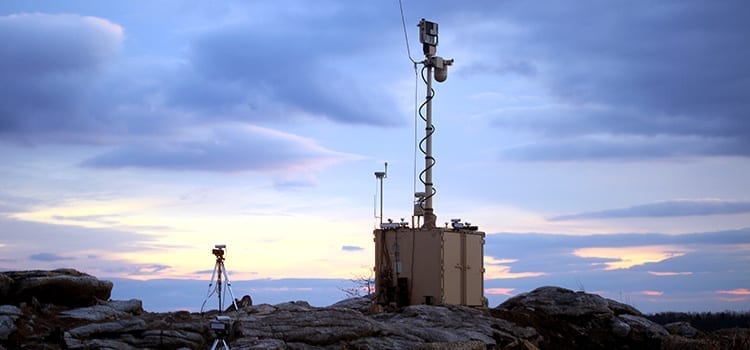At U.S. military installations around the world, military police monitor force protection sensors which consist of conventional and thermal imaging cameras, ground surveillance radar, and seismic and acoustic sensors. These installations also have chemical biological sensors, but they are operated as an independent system manned by chemical biological specialists in another location.
Project JUPITR’s Early Warning System aims to combine these powerful surveillance tools into a single integrated system so that military police and chemical biological specialists can immediately cross check their data and respond to incidents faster.
Project JUPITR’s Early Warning System
JUPITR stands for “Joint U.S. Forces in Korea Portal and Integrated Threat Recognition.” In June 2015, a team of Edgewood Chemical Biological Center’s (ECBC) chemical biological specialists and Joint Project Manager (JPM) Guardian software systems and hardware engineers performed an operational demonstration of a system of integrated force protection and chemical biological sensors at Osan Air Force Base in South Korea with U.S. Army and Air Force military police and chemical biological specialists.
“We had a system called the Joint All-Hazards Common Control Station (JACCS) that we use in Afghanistan. It features a common operating picture which displays all the force protection sensor data on one screen,” said Robert Bednarczyk, deputy product manager for Joint Product Manager Force Protection Systems and the leader of the early warning effort.
“We integrated the JACCS software to add additional data from chemical biological point sensors and standoff sensors to the JACCS common operating picture. We then held an exercise in which we simulated a threat. The military police at their location and the chemical biological specialists at another location were all looking at the same common operating picture at the same time, and seeing the same data streaming in from both the force protection and chemical biological sensors in real time.”
 Teamwork Streamlines Response
Teamwork Streamlines Response
The military police were able to notify the chemical biological specialists that a suspicious vehicle was in the area. The chemical biological specialists were able to watch the truck on screen and notify the military police that a standoff chemical biological sensor had alarmed.
That buys time, as much as three or four minutes depending on the distance, the wind and the configuration of the sensors. In that time, the base commander can be alerted and take charge of the response, base personnel can suit up in personal protective equipment, and the Army and Air Force chains of command can be notified.
The technical demonstration was the culmination of 14 months of hard work by the ECBC-JPM Guardian team. They had to select the right chemical biological sensors, which then had to be fully integrated into the JACCS system. Each of the eight sensors they selected spoke a slightly different language in computer terms. Establishing a common language required additional programming followed by interface testing, followed by more programming tweaks, and again, more interface testing.
“It was tedious and frustrating at times,” said Bednarczyk, “because it all came down to manipulating a staggeringly large number of ones and zeroes until the whole thing worked perfectly.”
Elbow Grease and Ingenuity
This was followed by a three-month integration assessment at Dugway Proving Ground. The team set up the array of sensors to be in exactly the same relative position they would be in at the upcoming operational demonstration at Osan. They tackled a major workaround based on prevailing wind directional differences between the two locales. They set the entire system up, tested it and broke it back down three different times, taking up to two weeks each time. They tested the system with simulants each time.
The Early Warning System was a hit at the operational demonstration. “The participants told us it was a vast improvement,” said Bednarczyk. “The military police look at the screens all the time as part of their job, to be able to bring in chemical biological specialists so fast and so completely the moment they saw something they suspected could involve chemical or biological agent was a big step forward in protecting the base.”
Next Steps for Project JUPITR
“The technical demonstration participants did everything much quicker using the system, but the question is, was it quick enough to justify the expense of installing it permanently?” said Strawbridge. That will be decided by the Joint Program Executive Office for Chemical and Biological Defense based on data they collected from the participants as they were using the system during the operational demonstration. The report is due out later this fall.
If the JPEO-CBD determines that the system demonstrates military utility, that leg of Project JUPITR will continue and it will be deployed to Osan for a two-year trial period.
Source: Edgewood Biological Chemical Center, adapted.



